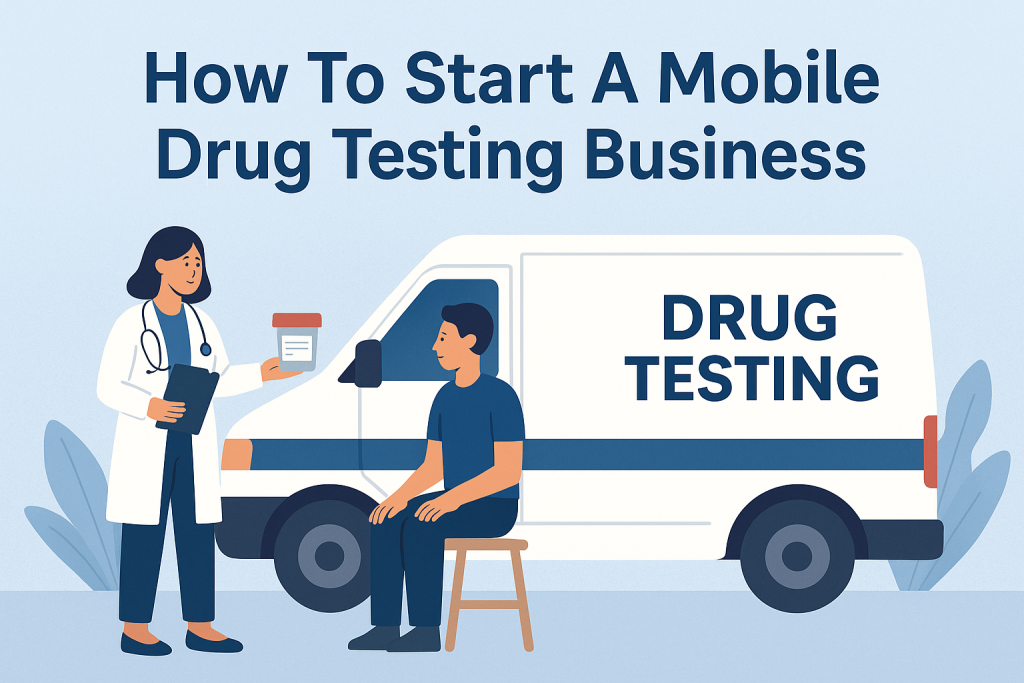Substance screening services are experiencing unprecedented demand across America. From transportation firms ensuring driver safety to schools addressing student wellness, organizations increasingly prioritize drug-free environments. Recent studies reveal over 20 million U.S. adults struggle with substance use disorders, with 70% actively employed. This creates consistent demand for convenient testing solutions.
Mobile operations eliminate traditional barriers by delivering services directly to clients. Companies avoid costly clinic visits while maintaining compliance with workplace safety regulations. Flexible scheduling and rapid response capabilities make this model particularly valuable for industries like trucking and construction, where on-site testing prevents workflow disruptions.
Entrepreneurs can serve diverse markets, including healthcare providers, educational institutions, and families managing addiction challenges. With 9% of workers reportedly dealing with substance-related issues, recurring revenue streams emerge through employer partnerships. Mobile setups require minimal upfront investment compared to physical facilities, accelerating business launch timelines.
Key Takeaways
- Growing demand spans corporate safety programs, schools, and healthcare providers
- 70% of individuals with substance disorders maintain employment
- Mobile models reduce overhead costs through location flexibility
- Urgent testing needs create premium service opportunities
- Multiple revenue streams from corporate contracts and private clients
This guide explores certification processes, legal considerations, and growth strategies for establishing a successful mobile screening operation. Discover how to navigate licensing requirements while building client relationships in this essential service sector.
Understanding the Mobile Drug Testing Industry
Economic pressures and safety mandates fuel rapid expansion within substance screening services. Organizations now prioritize prevention strategies that protect both productivity and lives. This sector connects hospitals, schools, and corporations through shared safety goals. To better understand the initial setup steps, consider this detailed guide on how to start a halfway house and align your efforts with best practices.
Current Market Landscape
The U.S. screening sector operates through diverse channels. Healthcare networks partner with transportation companies to meet federal compliance standards. Educational institutions implement random checks to deter student substance use. Workplace initiatives remain the largest revenue driver, accounting for 63% of all screenings last year.
Accident prevention remains central to this industry’s value. Untreated substance issues contribute to 35% of workplace injuries annually. Employers increasingly adopt multi-phase programs covering pre-hire evaluations and post-incident reviews.
Emerging Opportunities
Specialized markets offer accelerated growth potential. Transportation firms require DOT-certified testing every 90 days for safety-sensitive roles. Construction and manufacturing sectors show 18% annual growth in screening contracts.
Regional demand varies significantly. States with strict safety laws like Texas and California represent 40% of national service requests. Providers offering instant results and digital reporting capture premium clients faster.
“On-site solutions reduce downtime by 75% compared to clinic-based testing,” notes a recent industry report.
Technological advancements enable faster specimen analysis. Mobile units now deliver lab-grade accuracy in under 15 minutes. This efficiency drives adoption among time-sensitive industries seeking minimal operational disruption.
Essential Training & Certifications
Credentials form the backbone of any reliable screening operation. Proper training ensures compliance with federal standards while building trust with clients who need precise results. Discover proven strategies to grow an online presence and generate income in our comprehensive post on making money through blogging.
Core Certification Requirements
DOT credentials unlock contracts with transportation companies and safety-sensitive industries. This includes mastering breathalyzer calibration, alcohol strip usage, and urine collection protocols. BAT certification demands 8 hours of hands-on practice with evasion detection techniques.
Urine specimen collector training covers three critical areas:
- Chain-of-custody documentation
- Temperature verification methods
- Tamper-proof packaging procedures
Flexible Learning Paths
Hybrid programs combine online modules with in-person skill assessments. Virtual courses teach federal guidelines through interactive scenarios, while live workshops simulate real-world collection challenges. Many providers offer weekend sessions for working professionals.
-
You might also find it helpful to read our detailed walkthrough on creating a structured co‑teaching environment in this post: how to start a homeschool co‑op.
“Proper certification isn’t just paperwork – it’s your first line of defense against legal challenges,” emphasizes a DOT compliance officer.
Specialized credentials expand service offerings. Pipeline safety training covers unique hazardous material protocols, while healthcare-focused programs address HIPAA-compliant reporting. Annual refresher courses keep technicians updated on new testing technologies and regulatory changes.
Investing in thorough education positions your team as experts clients can depend on. This foundation becomes particularly valuable when handling sensitive cases or high-stakes corporate contracts.
how to start a mobile drug testing business
Launching a mobile screening venture requires strategic preparation. Begin by analyzing regional demand patterns and competitor service gaps. Focus on areas with high concentrations of safety-sensitive industries like logistics hubs or manufacturing districts.
Roadmap for Service Launch
Establish your legal structure early. Many operators choose LLCs for liability protection and tax flexibility. Partner with medical suppliers to source FDA-approved testing kits and mobile lab equipment.
Permitting varies by state – California mandates CLIA waivers for on-site analysis, while Texas requires specific vehicle certifications. Budget 6-8 weeks for license approvals before accepting clients.
“A detailed roadmap reduces startup delays by 40%,” states an SBA report on service ventures.
Crafting Your Operational Blueprint
Your operational blueprint should address three core elements: client acquisition strategies, revenue models, and scalability options. Include financial forecasts showing break-even points at different service volumes.
Factor in recurring expenses like lab partnerships and vehicle maintenance. Many successful ventures allocate 15% of initial funding for marketing to construction firms and healthcare networks.
Update your blueprint quarterly as you gather client feedback. This living document becomes critical when seeking expansion loans or attracting investors.
-
For entrepreneurs looking to capitalize on recurring revenue, learning how to establish a profitable car wash operation can be a game-changer.
Setting Up Mobile vs. Brick-and-Mortar Operations
Choosing between mobile and fixed locations shapes service delivery and profitability. Each model serves distinct client needs while presenting unique operational challenges. Let’s explore which approach aligns with different market demands.
Advantages and Disadvantages of a Mobile Unit
Mobile setups excel in flexibility. Vehicles like vans or motorhomes eliminate facility leases and utility bills. A converted RV with a bathroom handles urine tests professionally, while compact cars work for basic screenings.
“Mobile teams save clients 3-4 hours per test by avoiding off-site travel,” reports a transportation safety director.
Space limitations require smart organization. Stackable storage bins and wall-mounted racks keep supplies accessible. Fixed locations offer permanent workspaces but lock operators into long-term expenses. Consider client expectations – construction sites value mobility, while hospitals may prefer clinic consistency. Those interested in adding a high-margin service to their beauty or fashion brand should explore the practical tips in this article on launching a permanent jewelry venture.
| Factor | Mobile | Brick-and-Mortar |
|---|---|---|
| Startup Costs | $15k-$40k | $80k+ |
| Monthly Overhead | $500-$1,200 | $4k-$8k |
| Service Radius | 100+ miles | 5-10 miles |
| Client Perception | Convenient | Institutional |
Essential Equipment and Supplies for Mobile Testing
Reliable gear ensures accurate results anywhere. Prioritize DOT-approved kits with tamper-evident seals. Portable centrifuges and refrigerators maintain specimen integrity during transport.
Key items include:
- Digital temperature loggers
- Biohazard disposal systems
- Rapid saliva testers
- GPS-enabled scheduling software
Partner with labs offering consignment programs. Many provide free kits until specimens arrive for analysis. This reduces upfront expenses while guaranteeing compliant materials.
Navigating Legal, Regulatory, and Compliance Requirements
Compliance forms the cornerstone of trustworthy screening operations. Every step must align with shifting regulations while protecting client and employee rights. Let’s break down critical considerations for maintaining lawful practices.
Federal Standards Meet State Variations
The U.S. Department of Health and Human Services sets baseline protocols for all screenings. These include approved testing methods and lab certifications. However, state laws often add extra layers. Montana prohibits random employee tests without union agreements, while California mandates written policy disclosures.
Transportation companies face stricter rules. DOT-regulated employees must undergo immediate post-accident evaluations. Technicians need specialized training to handle these time-sensitive scenarios properly.
“Mixing federal mandates with local statutes requires constant vigilance,” advises a workplace safety attorney. “One oversight can invalidate entire test batches.”
Documentation: Your Legal Safety Net
Proper records transform speculative claims into defensible evidence. Chain-of-custody forms track specimens from collection to analysis. Each document must include:
- Participant identification verification
- Exact collection times
- Temperature-controlled storage logs
Digital systems now streamline this process. Cloud-based platforms timestamp entries and flag missing data. Regular audits ensure forms meet both HIPAA privacy rules and employer reporting needs.
Return-to-duty cases demand particular attention. Federal rules specify testing frequency after rehabilitation programs. Missing even one scheduled follow-up test can restart the entire compliance clock. Entrepreneurs interested in health services may find our guide on how to start a mobile DNA testing business a valuable resource for launching a flexible, science-driven venture.
Building a Client Base & Effective Marketing Strategies
Establishing a robust client portfolio demands strategic outreach across multiple industries. Transportation firms, construction crews, and healthcare networks each require tailored approaches. Schools and small businesses add further diversity to potential revenue streams.
Pinpointing Industry-Specific Needs
Transportation companies prioritize DOT compliance and rapid turnaround times. Construction managers value early-morning site visits to minimize downtime. Healthcare facilities need HIPAA-compliant reporting integrated with their systems.
Educational institutions often seek random testing programs with parental consent features. Small businesses benefit from bundled packages combining initial screenings with policy development guidance.
“Our mobile team became an extension of their HR department,” shares a client serving manufacturing plants across three states.
Multi-Channel Outreach Tactics
An SEO-optimized website ranks higher for searches like “urgent workplace screenings near me.” Local directories boost visibility among regional employers. Social media showcases quick response times through client testimonials.
Trade shows connect directly with safety managers. Networking groups reveal unaddressed market gaps. Referral discounts turn satisfied customers into active promoters.
Educational webinars position your team as compliance experts. Free policy templates encourage repeat engagements. Transparent pricing builds trust faster than competitors’ hidden fees.
Cost Management & Financial Planning
Smart financial strategies separate thriving ventures from struggling operations in the screening industry. Balancing upfront investments with recurring expenses demands precision – one miscalculation can erase thin profit margins.
Mapping Your Money Flow
Initial investments range from $15k-$40k for essentials:
- Specialized vehicles with privacy partitions
- DOT-approved testing kits and refrigerated storage
- State licensing and insurance bonds
Monthly costs average $1,200-$2,500. Fuel consumption fluctuates with service area size, while lab partnerships often charge per specimen analyzed. Budget tracking apps help monitor real-time spending across multiple expense categories.
Smart Pricing Structures
Successful operations use dynamic models:
- 20% discounts for contracts exceeding 100 tests monthly
- After-hours rates 40% higher than standard bookings
- Bundled packages for schools combining screenings with policy templates
“Operators maintaining 55%+ gross margins typically automate invoicing and negotiate bulk supply deals,” reveals a 2024 financial benchmarking study.
Target transportation hubs and manufacturing districts first – these sectors generate 68% of industry revenue. Use GPS routing software to cluster appointments geographically, cutting fuel costs by 30%.
Conclusion
Entrepreneurs seeking impactful ventures find mobile substance screening offers both purpose and profit. This accessible business model requires minimal upfront costs, with many labs supplying equipment through consignment programs. Certification processes often take less than two weeks, letting operators launch services quickly while meeting strict compliance standards.
The growing demand for workplace safety solutions creates multiple entry points. Schools, hospitals, and transportation companies all seek reliable partners who prioritize discretion and accuracy. Scalability becomes natural as client networks expand through repeat contracts and referrals.
Beyond financial rewards, these services strengthen community health initiatives. Early detection programs help reduce accidents while supporting recovery efforts. Your operation becomes a vital link in creating safer environments across diverse industries.
With recurring demand and flexible service models, mobile screening stands out as a socially conscious enterprise. Now is the time to position your business where compassion meets commerce in this essential field.







